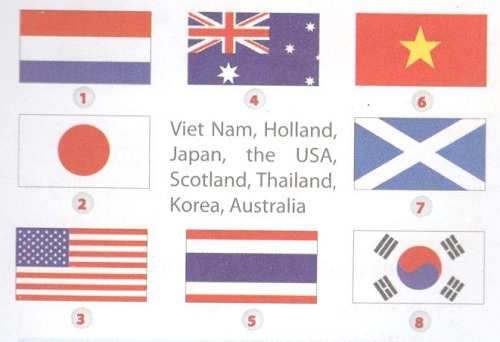Communication
Nội dung lý thuyết
Unit 6: Our Tet Holiday
Communication
1. Match the flags with the countries. Then match the countries with their nationalities.
(Nối các lá cờ với các quốc gia. Sau đó nối các quốc gia với các quốc tịch)

- Holland - Dutch (Hà Lan)
- Japan - Japanese (Nhật)
- The USA - American (Mỹ)
- Australia - Australian (Úc)
- Thailand - Thai (Thái Lan)
- Viet Nam - Vietnamese (Việt Nam)
- Scotland - Scottish (Scotland)
- Korea - Korean (Hàn Quốc)
2. Game:
Prepare pictures of flags. Walk around and meet people. Tell them where you are from. They will tell you your nationality.
(Chuẩn bị các bức tranh có hình lá cờ. Đi xung quanh và gặp gỡ mọi người. Sau đó nói cho họ biết bạn từ đâu đến. Họ sẽ nói cho bạn quốc tịch của bạn)
Ví dụ:
- A: Hi, I'm from England. (Xin chào, tôi đến từ Anh Quốc.)
- B: You're English. (Bạn là người Anh.)
1. A: Hi, I’m from Holland.
B: You’re Dutch.
2. A: Hi, I’m from Japan.
B: You’re Japanese.
3. A: Hi, Fm from the USA.
B: You’re American.
4. A: Hi, I’m from Australia.
B: You’re Australian.
5. A: Hi, I’m from Thailand.
B: You’re Thai.
6. A: Hi, I’m from Vietnam.
B: You’re Vietnamese.
7. A: I’m from Scotland.
B: You’re Scottish.
8. A: Hi, I’m from Korea.
B: You’re Korean.
3. People in different countries celebrate New Year differently. Match the four groups of people with the pictures
(Mọi người ở những quốc gia khác nhau ăn mừng năm mới theo những cách khác nhau. Nối 4 nhóm người với các bức tranh)
- The Scottish, Scotland
- The Thai, Thailand
- The H'Mong, Viet Nam
- The Japanese, Japan
4. Read the four paragraphs below. Use the pictures in 3 to help you decide which group of people celebrates New Year that way
(Đọc 4 đoạn văn dưới đây. Sử dụng các bức tranh trong phần 3 để giúp bạn quyết định xem những nhóm người sau đón năm mới như thế nào)
| New Year | People |
| a. On New Year's Eve, each family kills a rooster. They take some red feathers from the rooster and stick them to the drawings of the Sun in their house. This will start the New Year. | The H'Mong |
| b. Their New Year is in April, the hottest time of the year. One tradition is to throw water over people. They believe that this activity will bring a lot of rain in the New Year. | The Thai |
| c. At midnight on December 31, temples all over their country ring their bells 108 times. They believe that the ringing bells can remove their bad actions from the previous year. | The Japanese |
| d. To welcome the New Year, they clean their houses. The first footer is very important. They believe that the first footer on New Year's Day decides the family's luck for the rest of the year. | The Scottish |
Dịch:
- a. Vào đêm giao thừa, mỗi gia đình làm thịt một con gà trống. Họ lấy vài cái lông vũ màu đỏ của con gà trống và dán chúng lên những bức vẽ mặt trời trong nhà của họ. Đây sẽ là khởi đầu cho một năm mới.
- b. Năm mới của họ bắt đầu từ tháng 4, thời điểm nóng nhất trong năm. Có một truyền thống đó là họ té nước lên người người khác. Họ tin rằng hoạt động này sẽ mang lại nhiều mưa cho năm mới.
- c. Vào nửa đêm 31 tháng 12, các đền chùa khắp nước họ vang lên 108 tiếng chuông. Họ tin rằng rung chuông có thể loại bỏ những hành động xấu từ năm cũ.
- d. Để chào mừng năm mới, họ lau dọn nhà cửa. Người đặt chân đầu tiên vào nhà rất quan trọng. Họ tin rằng người xông đất ngày đầu năm mới sẽ quyết định vận may của gia đình cho suốt năm còn lại.
5. Find and check the meaning of some new words as they are used in the text by matching them with the definitions.
(Tìm và kiểm tra nghĩa của một số từ mới có trong bài đọc bằng cách nối chúng với định nghĩa)
| Text | Word | Definition |
| a | feathers (lông) | the covers of a rooster, chicken or bird (lớp bao phủ bên ngoài của một con gà trống, gà, chim) |
| b | rooster (gà trông) | an adult male chicken (một con gà giông đực dã trưởng thành) |
| c | remove (bỏ, xóa) | take away (mang đi) |
| d | first footer (người xông đất) | the first person to enter your home after newYear’s Eve (người đầu tiên đặt chân vào nhà bạn sau đêm Giao thừa) |
6. Group work
(Làm việc nhóm)
Each student chooses two facts from the four paragraphs he/she is most interested in. Write them down and take turns to read them aloud to his/her group. The group decides which group of people he/she is talking about.
(Mỗi học sinh chọn 2 sự việc từ 4 đoạn văn trên mà mình hứng thú nhất. Viết ra và sau đó lần lượt đọc chúng thật to cho cả nhóm nghe. Nhóm sẽ quyết định xem bạn ấy đang nói về nhóm người nào)
Ví dụ:
- At midnight on December 31, temples all over their country ring their bells 108 times. - They're Japanese.